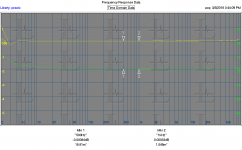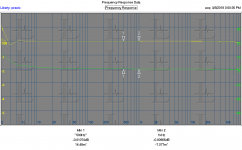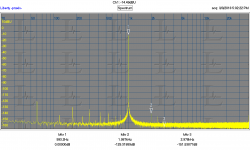I have, done left-left and right-right, the result is the same. I do the same split with different sound cards, generally though an additional test control box which basically has more passive connections in the middle. With RTX, I used a one to two split cable purchased from the web to keep things simple. I really cannot see how things can go wrong with a simple split. All connections are balanced.
Sample rate is 96KHz, 24bit. Windows 7 using MME drivers.
Sample rate is 96KHz, 24bit. Windows 7 using MME drivers.
Checked with another sound card, there seems to be a similar situation, but I need to get to comparible levels, this is getting complicated. I am not sure about how SoundEasy does convolution with MME drivers, they had a WASAPI version that would not work with USB cards, thus brought back the MME version. Does not work with ASIO.
Checked with another sound card, there seems to be a similar situation, but I need to get to comparible levels, this is getting complicated. I am not sure about how SoundEasy does convolution with MME drivers, they had a WASAPI version that would not work with USB cards, thus brought back the MME version. Does not work with ASIO.
Ok, so it's likely not a hardware issue. Smells like software to me. So again: Can you do the measurement without using one channel as the reference for the other (i.e., without deconvolution of the two channels)?
Hmm.. you are doing convolution with win mme drivers? How did you stop windows interacting with your signal? Cannot use ASIO?
I'd think the deconvolution is done in SoundEasy, not in the drivers ;-)
But yes, the drivers may mess with the data (resampling and stuff), resulting in artifacts showing up in the measurement. Stay away from drivers that mess with the data!
All in all, it would be useful to tell the software to use an impulse as a test signal, and show the result of this without any deconvolution.
Well deconvolution between the channels takes place when generating the frequency response, and CSD etc. so the impulse basically is a reconstruction from MLS data, and it does look very good except for the noise. I guess I will just check on my old pc and see what I get. The single channel option had been removed from in the latest version.
The talk about oscillation caught my intention, so I was wondering whether it is related with what I am seeing.
The talk about oscillation caught my intention, so I was wondering whether it is related with what I am seeing.
Last edited:
I just did a quick test with Praxis of a chirp based response. I did it with the reference and test channels reversed as well to look for differences. As you can see from the plots (which have no corrections applied) the results are essentially perfect. No errors above 5Hz. (I'm AC coupled) The impulse plot show a 1 sample long pulse so not interesting.
Praxis only uses the windows sound engine so no ASIO.
Third plot is distortion using a Victor 994Hz oscillator as the source. Level is -15 dBFS. The source is about 2.5V The only harmonic is H2 at -129 dB.
Praxis only uses the windows sound engine so no ASIO.
Third plot is distortion using a Victor 994Hz oscillator as the source. Level is -15 dBFS. The source is about 2.5V The only harmonic is H2 at -129 dB.
Attachments
If Praxis is using a reference channel, the frequency response should have a rectangular high end cut off and totally flat regardless AC coupling. The phase would basically be as flat as the grid lines.
Looking closer at the graphs, the normal and reversed channels do have some frequency and phase difference.
My other test computer unfortunately runs XP only, so I cannot plug the RTX into it, but I will run a test to find out how it compares using an Echo Indigo io card.
Looking closer at the graphs, the normal and reversed channels do have some frequency and phase difference.
My other test computer unfortunately runs XP only, so I cannot plug the RTX into it, but I will run a test to find out how it compares using an Echo Indigo io card.
Last edited:
Win 10 sample rate converts for every in and out for audio. You need to set all at the same sample rate individually or Windows converts.Not sure what you are talking about. Don’t think there is anything in Windows that involves sample rate sample rate conversion. The only difference is one machine runs WinXP and another runs Win7 64 bit.
XP was better for this.
Just a wild idea... could you use a small coil/inductor across the resistor in the ground wire? That wold give virtually 0 Ohm in the ground wire at audio frequencies, but the HF stuff would still see the resistor.
Yes this helps to a certain extend, it turns out that you even can leave the resistor away and couple only by the inductor, this do not change much.
There ground connection with 22R resistor only (red) over ground connection with 33uH inductor (green). The pictures are not entirely comparable, with the previous as I had the screen of the XLR connector not covering the connector for the modifications below.
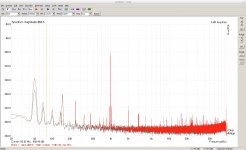
An other possibility to get the noise floor down is to connect the screen of the cable with an resistor (here 110 Ohm) to the XLR connector and connect the ground wire directly to the dedicated terminal.
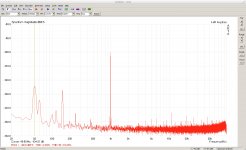
If I choose an 620R resistor, for connecting screen, the noise floor get up a little.
If I connect the screen by the inductor the noise floor is up again.
If I connect it with an capacitor the noise floor goes crazy.
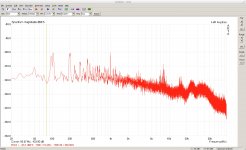
All is with 0dBV input setting connected to the DAM playing a -100dBV signal.
Win 10 sample rate converts for every in and out for audio. You need to set all at the same sample rate individually or Windows converts.
XP was better for this.
I thought if you give exclusive access to the sound card, this is all bypassed. Don’t have Win10.
In XP that's true, however Win 7 on the sound engine is very different. Exclusive access doesn't seem to overcome the sample rate issues. I found that I had to set everything manually. I use Win 10 and XP only these days so I can't really comment on Win 7 from recent experience.
Win7 and possibly all later versions use WASAPI, but Win7 also has MME. The I use the MME version of SoundEasy. Since the issue I have seems machine dependent, I suspect spread spectrum may be the cause. On the other notebook, spread spectrum can be disabled, but not on the MacBook.
Win7 and possibly all later versions use WASAPI, but Win7 also has MME. The I use the MME version of SoundEasy. Since the issue I have seems machine dependent, I suspect spread spectrum may be the cause. On the other notebook, spread spectrum can be disabled, but not on the MacBook.
Why don't you try with Mac OS on your MacBook? Do you see the same issue with some test software on Mac OS? REW or MATAA (and maybe others) are available for both Mac OS and Windows, so you could try and see if it's a Windows / driver thing.
I would like to find Mac software that can do at least CSD and wavelets out of the box. MLS signal is desirable. Don’t know any software that currently use these.
In real work, I use SoundEasy and Ultimate Equalizer from Bodzio software for speaker development since the process is quite integrated. Do not know any other software that replaces this.
However, it quite refreshing to find this issue with sample rate switching, I think I will explore it some more.
In real work, I use SoundEasy and Ultimate Equalizer from Bodzio software for speaker development since the process is quite integrated. Do not know any other software that replaces this.
However, it quite refreshing to find this issue with sample rate switching, I think I will explore it some more.
- Home
- Design & Build
- Equipment & Tools
- DIY Audio Analyzer with AK5397/AK5394A and AK4490
